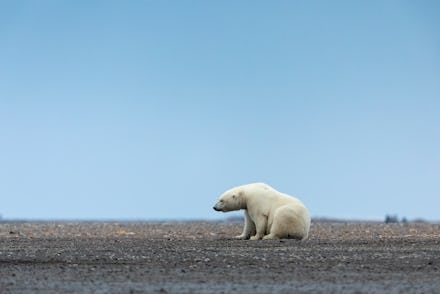Polar bears could largely starve to death by the end of the century

The Earth is continuing to warm, even in areas that we once thought were nearly immune to the effects of climate change. That spells trouble for basically every species on the planet, but new research found that polar bears are in for a particularly rough time if humans don't change course quickly. According to a paper published Monday in the journal Nature Climate Change, many species of polar bears could face extinction by 2100 if global warming continues at its current rate, the result of shrinking ice availability and dwindling food resources.
Scientists examined 19 subpopulations of polar bears that occupy land from the Beaufort Sea off the northern coast of Alaska to those living in the frigid Siberian Arctic in Russia, which recently experienced its hottest temperatures ever recorded. By using climate-model projections that predict weather conditions and the number of ice-free days that would be experienced in each region over the remainder of this century, along with "dynamic energy budgets" that predict how long bears could survive while fasting if their food sources start to disappear, the researchers were able to project how climate change would affect polar bears across the globe. The findings were not promising.
The projections found that in the short term, many polar bears are likely to starve to death. This will occur as feeding windows get shorter, with less time where ice is available and hunting is feasible. The downturn in food will cause the polar bears to extend their fasting periods, going longer without acquiring food. When bears fast, they move as little as possible to conserve their energy. They'll have less stored energy to preserve themselves in this state if they have less food available to them. Scientists note that during other warming periods, these bears often had access to alternative food sources that could sustain them even as temperatures climbed, such as whale carcasses. A study conducted by the University of Washington in 2018 found that those food sources are unlikely to be available to polar bears in the coming years, at least in large enough quantities to sustain the populations as their primary food sources are depleted.
Making matters worse, the loss of ice and shrinking population will require the polar bears to travel farther to find livable land and to track down a potential mate. That will make it harder for the species to reproduce, lessening its likelihood of survival. A 2018 study published in the journal Environmental Research Letters found that there could be ice-free days in the Arctic by 2040, which will leave the polar bears with little natural habitat to occupy.
The window for humans to turn things around and address climate change is continually closing, but it is even closer to being shut on polar bears. According to researchers, even the best efforts of humans may not be enough to save some of the bear populations. Even if carbon emissions peak by the year 2040 and steadily decline into the future, the models suggest that many polar bear species will be wiped out. Reversing the effects of climate change is like trying to turn around a cruise ship. Unfortunately for polar bears, it appears we've already hit an iceberg.